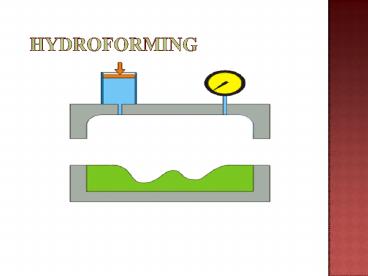HYDROFORMING - PowerPoint PPT Presentation
1 / 16
Title:
HYDROFORMING
Description:
Specially designed for mechanical engineers. A special type of die forming using a high pressure Hydraulic fluid to press room temperature working material into a die ... – PowerPoint PPT presentation
Number of Views:1969
Avg rating:3.0/5.0
Title: HYDROFORMING
1
HYDROFORMING
2
OUTLINE
3
HYDROFORMING
- A special type of die forming using a high
pressure Hydraulic fluid to press room
temperature working material into a die
4
History
- Discovered by HOLMSTROEM, MARTIN
5
There are three types of hydroforming 1.
Tube hydroforming 2. Sheet
hydroforming 3. Explosive hydroforming
6
TUBE HYDROFORMING
- Used when a complex shape is needed
- A section of cold-rolled steel tubing is placed
in a closed die set - A pressurized fluid is introduced into the ends
of the tube - The tube is reshaped to the confine of the cavity
7
SHEET HYDROFORMING
- Involves forming of sheets with application of
fluid pressure - Metal blank is subjected to hydraulic counter
pressure generated by punchs - Required deformation takes place
- Note Sheet hydroforming provides a
work-hardening effect as the steel is forced
against the blanks through fluid pressure.
8
Explosive hydroforming
- Used for large parts
- Generates the forming pressure by a simple
explosion above the part which is immersed in
water.
9
THE APPLICATION SPECTRUM
- 1. Outer skin with its extreme demand of surface
quality and dimensional accuracy. - 2. Longer outer skin parts for passenger cars,
utility vehicles - 3. Low capital cost. Fewer and simpler dies.
- 4. Better NHV (noise, vibration and harshness
)factors. - 5. Reduction in weight.
- 7. High process capability.
- 8. Reduction in cost of component.
10
MATERIALS
- Steel (mild and harder steels)
- Stainless Steel
- Aluminum alloys
- Research continues to expand the capabilities of
the hydroforming process
11
ADVANTAGES
- Extraordinary Design Flexibility.
- Fewer Parts
- Less Assembly
- Less Weight.
- Lower Tooling Costs.
- Less Post-Processing
- Greater Integrity (pressure flows the metal into
corners for greater precision rather than
streching)
12
ADVANTAGES (CONT.)
- Results compared to conventional
steel body structure - 50 less weight
- 45 less parts (less tools, less assembly)
- 45 less welding seams
- Tighter tolerances
Volvo Hydroformed Structure concept in Aluminum,
(Schuler Hydroforming 1998)
13
DISADVANTAGES
- Slow cycle time
- Expensive equipment and lack of extensive
knowledge base for process and tool design - Requires new welding techniques for assembly.
14
ECONOMICS
15
CONCLUSION
- Hydroforming is an innovative forming process
- Hydroforming is becoming more popular
(ie.automotive and aerospace industries) - The advantages outweigh the limitations
- Material selection is broad and continues to
increase - Information can be found everywhere!
16
QUESTIONS???

